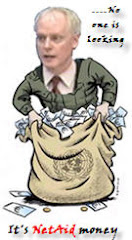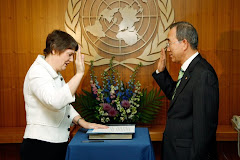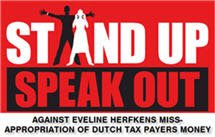The U.N.: Even More Expensive Than It Looks
Thursday , November 06, 2008
By George Russell

How much does the United Nations cost?
Rich countries, led by the United States, take note: you already pay about three times as much for the U.N. as appears on your own books — about $17.2 billion in 2006, according to figures newly pulled together in a U.N. report. And that number includes a whopping $800 million surplus for the sprawling U.N. system.
What the U.N. did with the extra cash isn't covered in the document that for the first time reveals the full extent of U.N. anti-poverty contributions and spending across 37 funds, agencies and programs.
But as the U.N. report itself states, the difference between the U.N.'s tallies and those of the 23-member Organization for Economic Cooperation and Development, which antes up most of the U.N.'s development funds, "present a very different image of the scale of United Nations operational and development activities."
• Click here to see the report.
The different image, in fact, is of a huge and rapidly growing organizational sprawl that is much more robustly funded by the world's rich countries than the general public, and most policymakers, believe.
And there is another shocker in the numbers: while the U.N. raked in $17.2 billion in contributions in 2006, the year covered by the report, it spent only about $16.4 billion on its own anti-poverty programs. Yet that number alone is greater than the $16.2 billion that donor nations recently pledged, at the U.N.'s urging, in additional funds to help the U.N. cut global poverty in half by 2015.
All of those figures are an order of magnitude greater than the roughly $2 billion that is normally bandied about as the cost of the U.N. Secretariat, headquartered in New York, and the roughly $5 billion usually tallied for the United Nations Development Program (UNDP), the U.N.'s development arm.
And the numbers are continuing to grow fast: at an average annual increase of 13 percent since 2002.
Even when adjusted for inflation, the U.N.'s operational cost is climbing at 5.7 percent annually. And some agencies, like UNDP and UNICEF, grew a lot faster, at an average 14.1 percent and 18.7 percent, respectively, in unadjusted terms, since 2002.
All of the statistics — and the revelation that Western donor statistics dramatically underestimate Western contributions — are contained in a dense and ground-breaking report to the U.N. General Assembly entitled "Comprehensive statistical analysis of the financing of operational activities for development of the United Nations system for 2006," which was originally published in May, but is only up for consideration by the U.N. General Assembly this week.
The report is the world organization's first attempt to compile financial data directly from all of the U.N.'s sprawling operations worldwide, rather than gathering much of it indirectly from a variety of other sources. And it is only a first step toward sorting out the U.N.'s bewildering global finances in a comprehensive fashion.
Even now, the report says, the U.N. does not prepare a consolidated statement of U.N. financing and expenditures, and indicates that such a document — common to the finances of most global corporations — is still in the distant future.
The operations tally is just a step along the way: an attempt to gather together the total amount spent by the U.N. to carry out its myriad development programs across a bewildering span of 37 agencies, funds, programs and commissions.
That by no means encompasses all U.N. spending on itself. For one thing, the report leaves out most of the cost of the U.N. Secretariat, including only the cost of the U.N.'s regional commissions and its Department of Economic and Social Affairs.
As the report's title says, the figures represent only the U.N.'s expenditures for development, leaving out such costly areas as peace-keeping, where the U.N. spent another $5 billion in 2005-2006 (and much more since then), or for humanitarian assistance, such as emergency flood and earthquake relief.
And, as this report warns, even the tallies contained in it "understate the total financing of the specialized agencies" — meaning organizations like the International Labor Organization, the Food and Agriculture Organization, the World Health Organization and the International Fund for Agricultural Development, to name just a few.
But even pulling together where all the U.N. operations spend their development money is a major achievement for the world organization. Its 37 components often do not talk to each other, use different baselines for their spending figures, and generally keep track of their finances in so many different ways that simply compiling the figures as this report does is a huge work in progress.
Until last year, overall financial data was collected directly from only five major U.N. funds and programs, and the rest gleaned from other documents. Data collection typically lags at least two years behind its publication.
Where is the anti-poverty money spent? Unsurprisingly, about 38 percent goes to desperately poor countries in Africa, up from just under 30 percent in 2002.
But some 15.4 percent is spent in middle-income Latin America, where countries such as Brazil and Argentina pour hundreds of millions of dollars into the U.N. system so that the money can be spent on — themselves.
This "self-supporting funding" especially benefits UNDP, which then channels the money back into Latin America, albeit outside the normal budget scrutiny of the countries that gave it.
As a result, UNDP's development spending in the world's poorest countries reached only 30 percent of its total spending in 2006 — far less than the World Food Program, and below the average of the entire U.N. system.
But perhaps the most surprising section of the report is an annex, which addresses the issue of "harmonizing contributions to the United Nations system," as tallied by the U.N. itself, vs. the tallies kept by the Organization for Economic Cooperation and Development (OECD) , the rich nations' club that foots most of the U.N. bill.
• Click here to see the annex.
As the new U.N. report explains, the OECD accounts fail to take account of so-called "non-core" spending by the various parts of the U.N., and instead only records "core," or regular budget, resources of some $5.1 billion.
"Core" spending is money that goes directly to the U.N. for spending on itself. "Non-core" resources are given to the U.N. to spend on projects that may be specified by the donor. But in both cases, the U.N. pays staff, buys whatever is required and — most importantly for the U.N. — usually charges a management fee for spending the money according to the donor's wishes.
The rich countries, however, list that money as assistance to poor countries as if the U.N. was not the middleman.
As a result, in 2006, "non-core" spending by the U.N.'s global empire amounted to $12.1 billion, which the OECD did not classify as U.N. spending at all.
As the report puts it, "the two methods give very different pictures of the size of the United Nations system's budgets for development."
Why the difference? The United Nations includes non-core contributions in its estimates, the report says, because it considers the purpose of both core and non-core government contributions "is to support its operational activities." The OECD countries do it differently because they see the U.N. agencies as "channels of delivery, as opposed to recipients of aid."
In addition, the OECD countries do not count private contributions to the U.N. for development as direct contributions, even though they totaled nearly $1.5 billion in 2006.
However the amounts are tallied, one fact remains a standout: the United States is far and away the biggest single contributor to the U.N. system. In 2006, the total U.S. contributions came to at least $2.7 billion — and that excludes the private sector, which by most independent estimates, draws most of its $1.5 billion in U.N. contributions from U.S. sources.
















































1 comment:
Corruption and mismanagement at UNDP headquarter for promotions at P5,D1 and D2 levels!if yu look at UNDP resident coordinator list. You can understand! what do yu think about that? Some resident coordinator have the D2 level and others have the D1 or P5 level.
Post a Comment